Edge bander Machine
The edge banding machine, is used to band the straight and curved panel edges for custom furniture production. A woodworking edge banding machine falls into the manual edge banding machine and the auto edge banding machine, specially designed for shops and companies looking for efficient and precise edge banding service and solutions.Functions of the automatic edge banding machine include pre-milling, gluing, banding, end cutting, rough and fine trimming, corner rounding, scraping, polishing, etc.
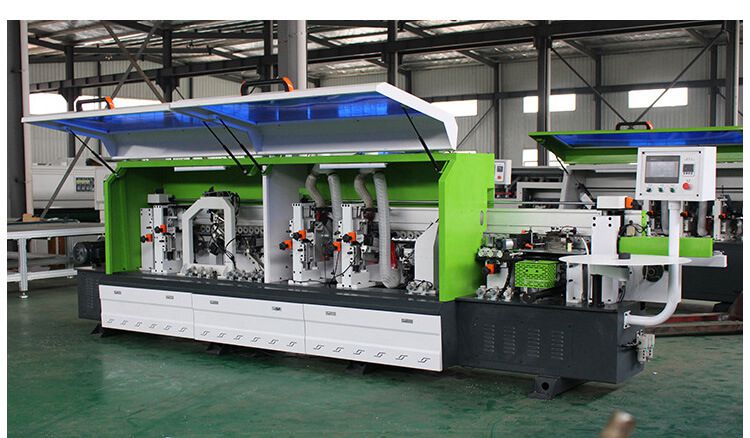
As we all know, cabinet edge banding plays an important role in furniture production. Good edge banding makes the cabinets more beautiful and smoother. Besides, it can effectively control the release of formaldehyde in the panel, making our home more environmentally friendly. Therefore, the edge bander is an indispensable furniture making machine for the whole panel furniture production line.
A banding machine for cabinet edges mainly includes the main structure, multiple processing units, and the control system. The processing units include the pre-milling unit, banding tape conveying unit, banding unit, cutting unit, trimming unit, rounding unit, scraping unit, and polishing unit. Each of these units corresponds to one separate function.
Relying on the advantages of high automation, stable operation, reliability, durability, and moderate price, edge banding machines are especially suitable for large and medium-sized furniture, cabinets, and other panel furniture manufacturers.
An edge bander, also known as an edge bander, is a specialized woodworking machine used to apply edgebanding materials to the edges of panels, such as plywood, particleboard, or MDF (medium-density fiberboard). Edgebanding is commonly used to provide a finished look, enhance durability, and protect the exposed edges of these panels.
Edgebanding machines are widely used in industries such as furniture manufacturing, cabinetry, woodworking shops, and interior design. They offer efficient and precise edgebanding processes, reducing manual labor and ensuring consistent results. It’s important to follow proper safety protocols and manufacturer guidelines when operating an edgebanding machine.
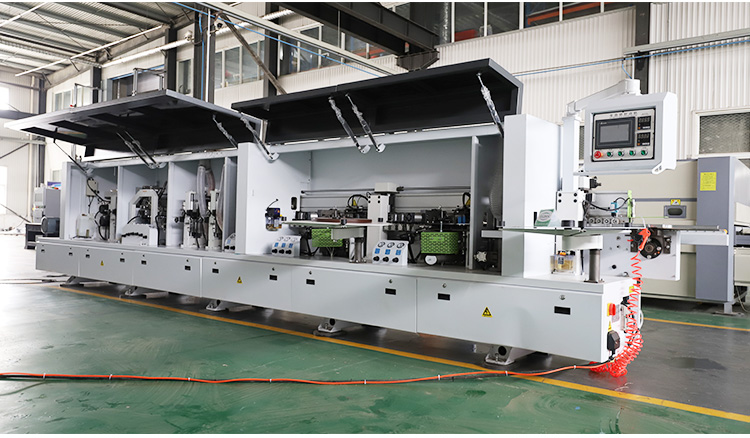
- Enhanced Aesthetics: Edge banding machines apply a thin strip of material (edge band) to the edges of furniture panels, providing a finished and polished look. This enhances the overall aesthetics of the furniture by covering raw edges and creating a seamless appearance.
- Durability and Protection: The edge banding process not only adds to the visual appeal but also enhances the durability of the furniture. It protects the edges from wear and tear, moisture, and other environmental factors, thereby increasing the lifespan of the finished product.
- Versatility: Edge banding machines are versatile and can handle various materials, including wood, PVC, ABS, and veneer. This versatility allows manufacturers to work with different materials based on the specific requirements of the project.
- Efficiency and Speed: These machines automate the edge banding process, leading to increased efficiency and faster production times. Automated edge banding machines can handle large volumes of work in a relatively short period, contributing to overall productivity.
- Cost Savings: While there is an initial investment in acquiring an edge banding machine, the long-term benefits often include cost savings. The efficiency and automation of the process reduce labor costs, and the machine helps minimize material wastage.
- Consistent Quality: Edge banding machines ensure uniform and consistent application of edge banding material. This results in a high level of precision and quality in the finished product, meeting the standards expected in the furniture industry.
- Customization: Manufacturers can use edge banding machines to customize furniture by choosing different edge banding materials, colors, and finishes. This level of customization caters to diverse customer preferences and market demands.
- Edge Profiles: Edge banding machines offer the flexibility to create various edge profiles, including straight edges, beveled edges, and rounded edges. This allows manufacturers to achieve specific design requirements for different furniture styles.
- Reduced Manual Labor: The automation of the edge banding process reduces the reliance on manual labor for applying edge banding materials. This not only increases efficiency but also minimizes the risk of errors associated with manual application.
Edgebander Application
The wood edge banding machine is mainly used for edge banding of medium-density fiberboard, wood board, solid wood board, particleboard, high-gloss board, plywood, etc. That’s the reason why the edge bander is also called the plywood edge banding machine, melamine edge banding machine, MDF edge banding machine, etc. In terms of wood materials, it can complete birch edge banding, maple edge banding, walnut edge banding, and other wood veneer edge banding work.
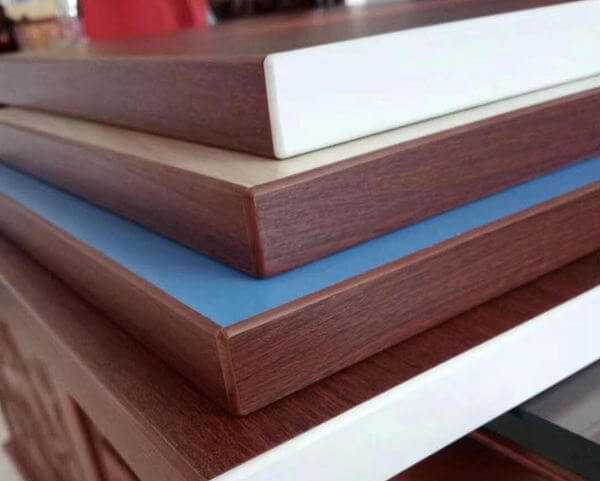
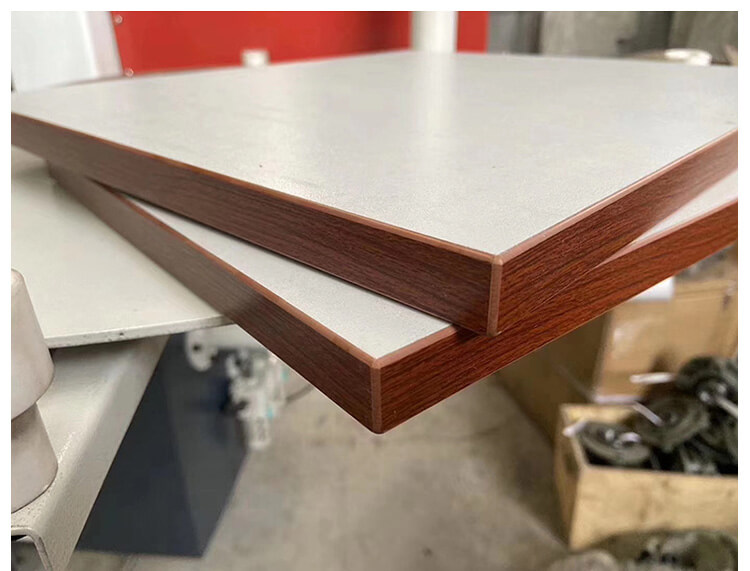
- Furniture Manufacturing: Edge banding machines are extensively used in the production of various types of furniture, including cabinets, tables, chairs, and shelving units. They are employed to apply edge banding materials to the exposed edges of furniture panels, providing a finished and polished look.
- Cabinet Making: In the production of cabinets, edge banding machines play a crucial role in finishing the edges of cabinet doors, drawers, and other components.
- Kitchen and Bathroom Fixtures: Edge banding is widely applied in the manufacturing of kitchen and bathroom fixtures to enhance the aesthetics and durability of these components.
- Office Furniture: Manufacturers of office furniture use edge banding machines to ensure a professional and polished appearance for desks, conference tables, and storage units.
- Retail Fixtures and Displays: Edge banding is applied to the edges of retail fixtures and displays to create a seamless and attractive finish, contributing to the overall presentation of products.
- Residential and Commercial Interiors: Edge banding machines are used in the production of interior elements such as doors, panels, and trim to achieve a refined and durable finish.
- Custom Furniture Production: For companies specializing in custom furniture, edge banding machines offer the flexibility to cater to unique design requirements by providing a variety of edge banding materials, colors, and profiles.
- High-Volume Production: Edge banding machines are particularly beneficial in high-volume production environments where efficiency and speed are crucial. These machines can handle large quantities of work in a short period, contributing to increased productivity.
- Versatile Materials: Edge banding machines can work with a variety of materials, including wood, PVC, ABS, and veneer. This versatility allows manufacturers to choose the most suitable material for the specific project requirements.
- Custom Edge Profiles: Manufacturers can use edge banding machines to create custom edge profiles, allowing for design flexibility and the ability to meet specific aesthetic preferences. In essence, edge banding machines find applications in any scenario where a
The fully automatic edge banding machine has extensive use in middle and large-sized furniture making factories. It has such advantages as stable operation, high automation level, reliable performance, and affordable price. Furthermore, the automatic edge bander machine is an indispensable CNC machine in many furniture production lines.
The manual edge banding machine is good at banding both straight and irregular edges. It is the best edge banding machine for small shops. Besides, it is possible to move the manual edge bander machine from one workplace to another for on-site banding operation.
The primary function of an edgebanding machine is to apply edgebanding material to the edges of panels. Edgebanding materials can include PVC, ABS, wood veneer, melamine, or acrylic strips. The machine applies the edgebanding material using heat, pressure, and adhesive to bond it to the panel’s edge.
Function introduction of edgebanding machine
Most automatic industrial edgebanding machine on the current market can realize basic 5 functions. These functions include gluing and banding, end cutting, trimming, scraping, and polishing.
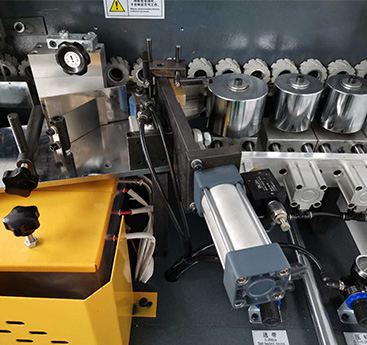
Basic functions:
Gluing and banding: There are six pressing wheels (1 big + 5 small) to press the banding tape after applying hot melt glue. It ensures no sliding and firm sticking of the banding tape. The cylinder controls the opening and closing of the glue pot gate to ensure the stability of the glue quantity and uniform thickness.
End cutting: This function aims to cut the excessive edge banding tape at both ends of a wooden board. It is realized by saw blades driven by two sets of high-speed motors. The end cutting unit of an edge bander generally has two types: ordinary end cutting and high-speed double guide rail end cutting. There is a cylinder (with 2 pressure regulating valves and 1 pressure relief valve) to help stabilize the pressure.
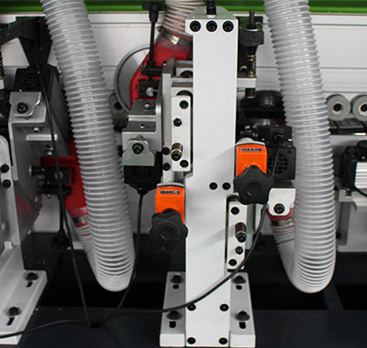
Trimming: The function aims to use a trimming knife to remove the excess edge banding material above and below the edge band of the plate. It includes rough trimming and fine trimming processes, with the major difference lying in the different shapes of the trimming knives. A cheap edgebanding machine may only have the rough trimming function. Correspondingly, the banding effect will not be too delicate and smooth.
Scraping: The edge bander can also scrape off the corrugated traces generated during the process of curve edge banding. And it can ensure that the edge banding of the plate and the surrounding parts are smooth. Now, flexible scraping is very popular. Its scraping effect is very good, and it does not hurt the edge band or the board.
Polishing: The function of polishing is to polish the burrs and residual glue lines of the panel to make the banded edges smoother. It is realized by a cotton polishing wheel. Upgraded functions:
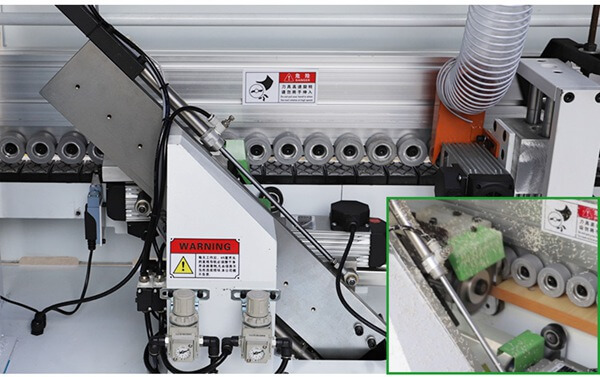
Pre-milling: This function is mainly to modify the uneven plate or the ripple, burr, or non-vertical phenomenon caused by the cutting saw. The purpose is to make the plate sealing boundary surface smooth to make the edge banding tape and the plate fit closely. Thus, it can achieve a better edge banding effect. This is a function added before the gluing process.
Profiling tracking: It is also called the corner rounding function. This function aims to round the banded corners to make them smoother and less sharp. Our self-designed tracking function and gas path design make this function more stable and precise.
Cleaning: It aims to clean the residual glue in the glue pot to make the edgebander machine more pretty.
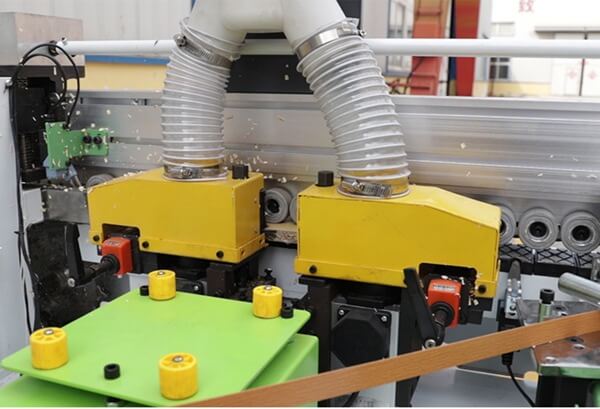
Slotting: It can directly groove the wardrobe side panels, bottom plates, etc. And it can also groove the aluminum edge of door panels, reducing the process of panel sawing.
Pneumatic adjustment of cutter: This function is conducive to replace the panel type, panel thickness, and banding tape. It allows the operator to adjust the edge band thickness from the screen directly.
Upper glue pot: By default, the glue pot of the wood edge bander is located in the lower position. It supports the use of multiple types of hot melt glue. The most commonly used glue is EVA glue. But if you want to use PUR glue to band your cabinets, you may need a upper glue pot edge bander machine.
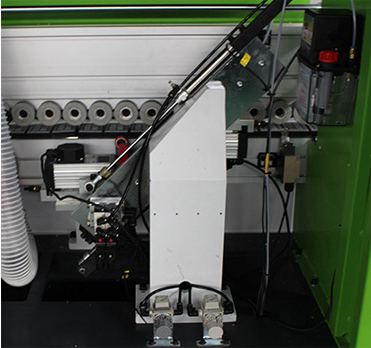
Double glue pots: Double glue pots allow you to use two different types of glue for your cabinet edge banding. It saves much time frequently cleaning the glue pots when you use glue of different colors.

IGOLDEN BLOG
Thank you for visiting the iGOLDENCNC website. iGOLDENCNC is the professional supplier of CNC machinery application solution, within the business of producing and selling CNC machinery and accessories.